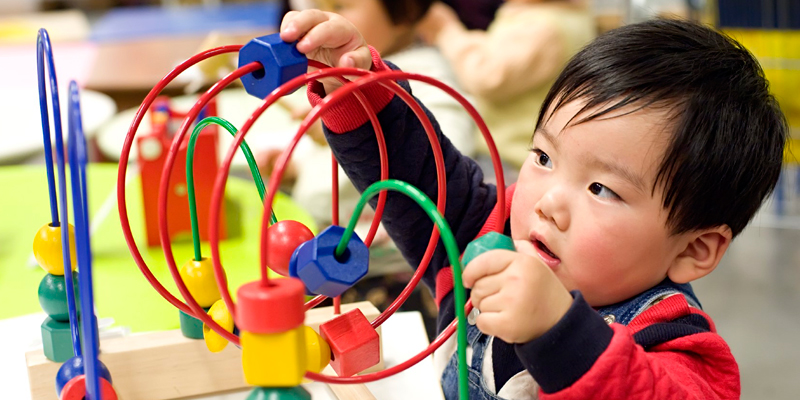
The Importance of Hand-Eye Coordination to Your Toddler’s Learning and Social Development
At 12-18 months of age, your baby is learning a lot about her environment through trial and error. She’ll experiment with different toys and household objects, observing the results of her actions to see if she can control and change her environment as well as get your attention!1,2 Much of what she learns at this age is through observation and something called haptic perception, the process of using touch to collect sensory information.3
Sometimes your baby will use a combination of touch and sight (hand-eye coordination) to learn about the world around her. Hand-Eye Coordination is her ability to process and use visual information to direct her hands to complete a certain task, such as picking up a cup or throwing a ball.4 It uses the eyes to take in information, while using the hands to carry out the task.4
(SPECIAL OFFER: Sign up for Playful Bee’s Bee Well developmental learning program to give your baby the best start in life. The first 10,000 children enroll for FREE! Sign up today.)
With her growing ability to coordinate her sight and hand motions, you’ll see her “use objects and toys more purposefully now, exploring Cause and Effect relationships.”5,6 Your baby has been visually tracking (i.e. following moving objects with her eyes) for a while now, and she will soon try throwing objects within her reach and guessing where they will land. Other activities she’ll try with her improving Hand-Eye Coordination include building towers out of blocks, playing with shape puzzles (and getting better at them!), and filling and dumping containers with toys, water, and other fun objects.
Because you are still one of her favorite toys and playmates, she’ll want to show off her growing Hand-Eye Coordination skills by playing with you and other favorite people. Some games she might want to play include rolling a ball back and forth with you5 or handing toys to you in a “give and take” game.
Support the development of strong Hand-Eye Coordination skills by keeping her busy doing things that work her fine motor muscles in combination with visual skills. Scientists at Indiana University have found another bonus to good hand-eye coordination: it is strongly tied to good learning abilities and social communication skills.7 So, keep your baby busy with activities that will give her practice coordinating her sight and motions. Include picking up toys from the floor during clean up time, filling and pouring sand at the beach or park, or doing wooden shape puzzles.
Play Tips:
Do you want to know how you can support your baby’s development of Hand-Eye Coordination skills at this age? It’s easy! Read on for some simple tips to incorporate into your daily play time together.
- Build your baby’s knowledge as she plays with toys and household objects.8 As your baby plays with her toys and common objects, try to build her knowledge by using task-centered talk. With task-centered talk, you describe everything that she is experiencing during an activity, including shapes, colors, textures, and other physical characteristics.5This will help build your baby’s Knowledge of Common Objects as well as grow her vocabulary.
- Keep a wide variety of tactile toys and objects to play with.6 Because your baby is still learning through exploring her senses, give her a variety of items made of different materials and textures to experiment with, including containers with blocks of different sizes, large wooden beads, stuffed animals, and board books.9 To avoid boredom, avoid “one-trick pony” toys, such as simple “one-press button, electronic toys.” Do consider giving her things that can be used in a variety of ways, such as building blocks which can be made into towers, dropped onto the floor, and filled and dumped out of containers.
(SPECIAL OFFER: Sign up for Playful Bee’s Bee Well developmental learning program to give your baby the best start in life. The first 10,000 children enroll for FREE! Sign up today.)
Developmental Milestones:
Has your baby achieved the following Hand-Eye Coordination developmental milestones yet? If yes, check off all the skill(s) she has already mastered to date using Playful Bee’s developmental milestones tracker. It’s absolutely FREE and easy to use, just click HERE!
- Likes to hand objects to others during play.
Sources:
1Piaget, Jean (1983). Piaget’s Theory. In P. Mussen (Ed.), Handbook of Child Psychology, Volume 1 (4th ed.) (pp. 103-128). New York, NY: John Wiley & Sons.
2Piaget, Jean (1952). Logic and Psychology. In Howard E. Gruber and J.. Jacques Voneche (Eds.), The Essential Piaget (pp. 445-477). New York, NY: Basic Books, Inc.
3Streri, Arlette; and Spelke, Elizabeth S. (1988). Haptic Perception of Objects in Infancy. Cognitive Psychology; 20 (1): 1-23.
4Encyclopedia of Children’s Health. Hand-Eye Coordination. Encyclopedia of Children’s Health. Retrieved March 3, 2014, from http://www.healthofchildren.com/G-H/Hand-Eye-Coordination.html.
5Maryland State Department of Education (2010). Healthy Beginnings: Supporting Development and Learning from Birth through Three Years of Age.
6Washington State Department of Early Learning (2012). Washington State Early Learning and Development Guidelines: Birth through 3rd Grade.
7Bergland, Christopher (2013). Hand-Eye Coordination Improves Cognitive and Social Skills. Psychology Today: The Athlete’s Way. Retrieved March 20, 2013, from http://www.psychologytoday.com/blog/the-athletes-way/201311/hand-eye-coordination-improves-cognitive-and-social-skills.
8Gellens, Suzanne R. (2013). Building Brains. St. Paul, MN: Redleaf Press.
9Utah Department of Workforce Services, Office of Child Care. Utah’s Early Learning Guidelines: Birth to Age Three.
Playful Bee
Latest posts by Playful Bee (see all)
- Have a Super Fortune Cookie Friday! - February 9, 2018
- All Kinds of Shapes: Your Child Is Learning Simple Shapes, and Drawing Them Too! - November 13, 2017
- Fishing for Sneakers: Create your own Hand-Eye Coordination Fun - November 11, 2017

+ There are no comments
Add yours